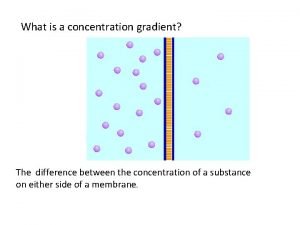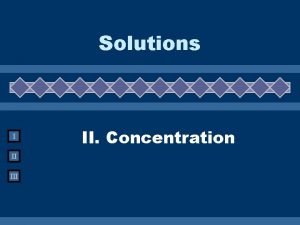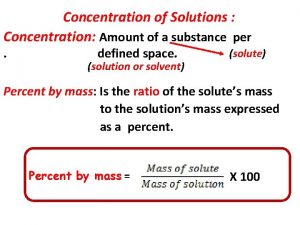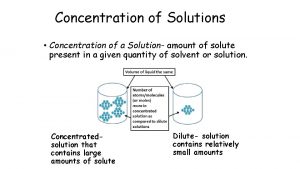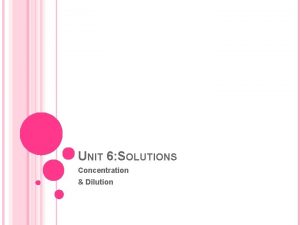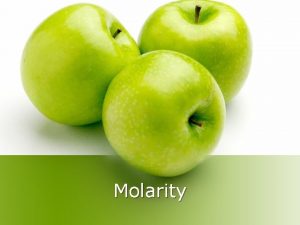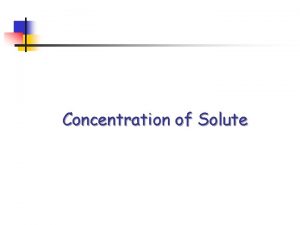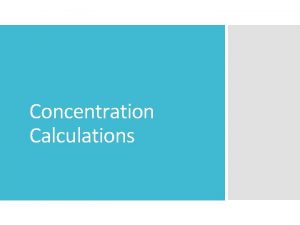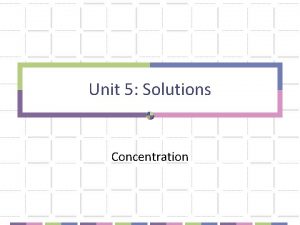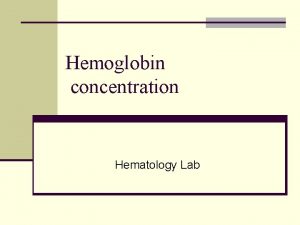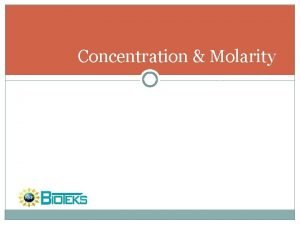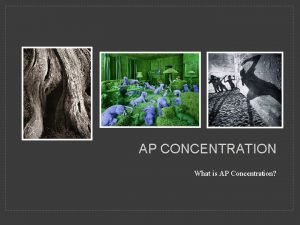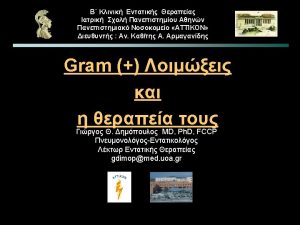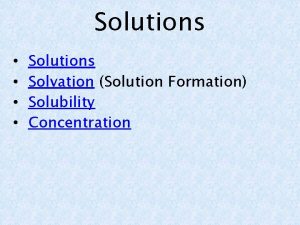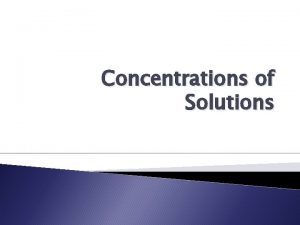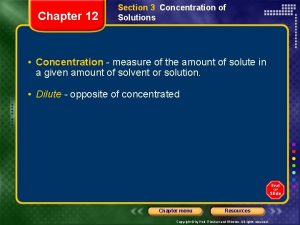CHAPTER 12 Concentration Terms for Solutions Concentration Amount










































- Slides: 42

CHAPTER 12: Concentration Terms for Solutions • Concentration = Amount solute/amount solvent • Some Concentration Terms are Temperature Sensitive

Concentration Terms • Molarity (M) = moles of solute/liter(s) of solution – TEMPERATURE SENSITIVE • How many grams of NH 3 are in 25. 5 ml of 0. 15 M NH 3 (aq) ?

CONCENTRATION TERMS: Molality • Molality (m) = moles of solute/kg of solvent

Molality (m) • Not Temperature Sensitive – What is the molal (molality) of glucose C 6 H 12 O 6, a sugar found in many fruits, in a solution made by dissolving 24. 0 g of glucose in 1. 0 kg of water.

Concentration Terms: Mole Fraction • Mole Fraction (X) = moles component/total moles in solution – Not Temperature Sensitive

Ways of Expressing Concentration Mole Fraction, Molarity, and Molality

• A solution is made containing 7. 5 grams CH 3 OH in 245 grams H 2 O. – Calculate (a) the mole fraction of CH 3 OH

Concentration Terms: Percent by Mass • Percent by Mass= (weight of solute/total weight of solution) (100) • Not Temperature Sensitive

• A solution is made containing 7. 5 grams CH 3 OH in 245 grams H 2 O. • Calculate (b) the mass percent of CH 3 OH

Chang Text Problem 12. 22: Page 546 The concentrated sulfuric acid we use in the laboratory is 98. 0 percent H 2 SO 4 by mass. Calculate the molality and molarity of the acid solution. The density of the solution is 1. 83 g/ml.

Chang 12. 24: Page 547 • The density of an aqueous solution containing 10 percent of ethanol (C 2 H 5 OH) by mass is 0. 984 g/ml. (a) Calculate the molality; (b) Calculate the molarity; (C ) What volume of the solution would contain 0. 125 mole of ethanol?

Problem 12. 22: Page 535 1. Assume you have 100 grams of solution. 2. Mass % = [mass solute/mass solute + mass H 2 O] 100 3. Have 98 grams of solute (98%). Have 2. 0 grams of H 2 O. 4. Molality = moles of solute/kg of solvent

Problem 12. 22: Page 535 • Molarity = moles solute/liters of solution Have 100 g of solution. Use density of the sulfuric acid solution to calculate volume. Calculate moles of sulfuric in 98. 0 grams

Colligative Properties • Physical properties of a solvent which depend upon the amount of solute present in a solution. (1) Lowering the Vapor Pressure • Non-volatile solvents reduce the ability of the surface solvent molecules to escape the liquid. • TEMPERATURE SENSITIVE • The amount of vapor pressure lowering depends on the amount of solute.

Colligative Properties Of Nonelectrolyte Solutions: Vapor Pressure Raoult’s Law • Raoult’s Law: PA is the vapor pressure with solute, PA is the vapor pressure without solvent, and A is the mole fraction of A, then • Recall Dalton’s Law:

Raoult’s Law • Remember in a Gas Mixture • PT = Pi(one) + Pi(two) + pi(three)…… • With Multiple Solutes • Ptotal = XA(PA◦) + XB(PB◦) + …….

Colligative Properties: Vapor Pressure Raoult’s Law • Ideal solution: one that obeys Raoult’s law. ▲PA =(X solute) (Vapor Pressure Pure Solvent) Boiling-Point Elevation • Goal: interpret the phase diagram for a solution. • Non-volatile solute lowers the vapor pressure. • Therefore the triple point - critical point curve is lowered.

Problem • Calculate the mass of propylene glycol (C 3 H 8 O 2) that must be added to 0. 500 kg of water to reduce the vapor pressure by 4. 60 torr at 40 ºC.

Colligative Properties: Boiling Point • BOILING POINT IS TEMPERATURE AT WHICH, VAPOR PRESSURE = EXTERNAL ATMOSPHERIC PRESSURE

Colligative Properties: Boiling Point Boiling-Point Elevation • Non-volatile solute lowers the vapor pressure. • Therefore the triple point - critical point curve is lowered. • ▲Tb = Kb m

Colligative Properties

Colligative Properties: Freezing-Point Depression • The solution freezes at a lower temperature ( Tf) than the pure solvent.

Colligative Properties: Freezing Point Freezing-Point Depression • When a solution freezes, almost pure solvent is formed first. – Therefore, the sublimation curve for the pure solvent is the same as for the solution. – Therefore, the triple point occurs at a lower temperature because of the lower vapor pressure for the solution. • The melting-point (freezing-point) curve is a vertical line from the triple point.

Colligative Properties

Table 12. 2

• Using data from table, calculate the freezing and boiling points of each of the following solutions. (a) 0. 35 m glycerol (C 3 H 8 O 3) in ethanol • ▲Tb = Kb m • from table 13. 4, normal boiling point for ethanol is 78. 4 ºC; Kb is 1. 22 ºC/m • ▲Tf = Kf m • Normal freezing point for ethanol is -114. 6 Celsius degrees; Kf 1. 99 ºC/m

Problem 12. 56: Page 548 • An aqueous solution contains the amino acid glycine (NH 2 COOH. Assuming that the acid does not ionize in water, calculate the molality of the solution if it freezes at -1. 1 Celsius.

• ▲Tf = Kf m • Kf = 1. 86 Celsius/m

Colligative Properties Freezing-Point Depression

Colligative Properties: Osmosis Movement of a solvent from an area of high solvent concentration to an area of low solvent concentration across a semi permeable membrane.

Figure 12. 11

Figure 12. 11 a

Figure 12. 11 b

Colligative Properties Osmosis • Osmotic pressure, , is the pressure required to stop osmosis:

DETERMINATION OF MOLAR MASS • Usually use freezing point depression or boiling point elevation. • Process – Calculate molality or Molarity – Need to be given mass of solute. – Calculate molar mass: mole = grams

• A 1. 2436 gram sample of an unknown electrolyte is dissolved in 10. 9303 grams of benzophenone which produces a solution that freezes as 43. 2 ◦ C. If pure benzophenone melts at 48. 1 ◦ C, what is the molecular weight of the unknown compound? Kf =9. 8 ◦C/m

• ▲Tf = Kf m • ▲Tf = 4. 9 C • 4. 9 C = [9. 8 C/m] [m] • [m] = 0. 50 moles in one kg of benzophenone • Used 0. 010903 kg of solvent. [0. 50 moles/kg] [0. 010903 kg] = 0. 0054515 moles

• Molar mass = grams of compound/moles of compound • Molar Mass = 10. 903 grams/0. 50 moles = 21. 81 grams/mole

Colligative Properties of Electrolyte Solutions • Electrolytes: Solutes which dissociate into ions in solution – Ionic Solutes (Na. Cl) – Acids (HCl) – Bases

Colligative Properties of Electrolyte Solutions • I = actual number of particles in solution after dissociation/number of formula units initially dissolved in soln


Problem 12. 72: Page 549 • Arrange the following aqueous solutions in order of decreasing freezing point, and explain your reasoning. 0. 050 HCl; 0. 50 m glucose; 0. 50 m acetic acid.
 Concentration gradient vs concentration difference
Concentration gradient vs concentration difference Movement of high concentration to low concentration
Movement of high concentration to low concentration Polynomial classification
Polynomial classification Like terms in algebra
Like terms in algebra Solutes and solvents grade 7 science
Solutes and solvents grade 7 science Adding water
Adding water Kontinuitetshantering i praktiken
Kontinuitetshantering i praktiken Novell typiska drag
Novell typiska drag Tack för att ni lyssnade bild
Tack för att ni lyssnade bild Vad står k.r.å.k.a.n för
Vad står k.r.å.k.a.n för Varför kallas perioden 1918-1939 för mellankrigstiden?
Varför kallas perioden 1918-1939 för mellankrigstiden? En lathund för arbete med kontinuitetshantering
En lathund för arbete med kontinuitetshantering Underlag för särskild löneskatt på pensionskostnader
Underlag för särskild löneskatt på pensionskostnader Tidbok för yrkesförare
Tidbok för yrkesförare Sura för anatom
Sura för anatom Vad är densitet
Vad är densitet Datorkunskap för nybörjare
Datorkunskap för nybörjare Boverket ka
Boverket ka Hur skriver man en tes
Hur skriver man en tes Delegerande ledarskap
Delegerande ledarskap Nyckelkompetenser för livslångt lärande
Nyckelkompetenser för livslångt lärande Påbyggnader för flakfordon
Påbyggnader för flakfordon Vätsketryck formel
Vätsketryck formel Publik sektor
Publik sektor Bo bergman jag fryser om dina händer
Bo bergman jag fryser om dina händer Presentera för publik crossboss
Presentera för publik crossboss Argument för teckenspråk som minoritetsspråk
Argument för teckenspråk som minoritetsspråk Plats för toran ark
Plats för toran ark Klassificeringsstruktur för kommunala verksamheter
Klassificeringsstruktur för kommunala verksamheter Fimbrietratt
Fimbrietratt Claes martinsson
Claes martinsson Centrum för kunskap och säkerhet
Centrum för kunskap och säkerhet Lågenergihus nyproduktion
Lågenergihus nyproduktion Mat för unga idrottare
Mat för unga idrottare Verktyg för automatisering av utbetalningar
Verktyg för automatisering av utbetalningar Rutin för avvikelsehantering
Rutin för avvikelsehantering Smärtskolan kunskap för livet
Smärtskolan kunskap för livet Ministerstyre för och nackdelar
Ministerstyre för och nackdelar Tack för att ni har lyssnat
Tack för att ni har lyssnat Referatmarkering
Referatmarkering Redogör för vad psykologi är
Redogör för vad psykologi är Matematisk modellering eksempel
Matematisk modellering eksempel Tack för att ni har lyssnat
Tack för att ni har lyssnat
